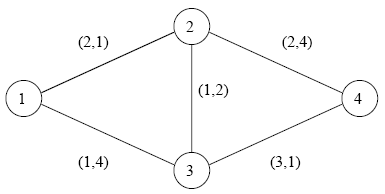363 . Bicriterial routing
Description
The network of pay highways in Byteland is growing up very rapidly. It has become
so dense, that the choice of the best route is a real problem. The network of highways
consists of bidirectional roads connecting cities. Each such road is characterized by
the traveling time and the toll to be paid.
The route is composed of consecutive roads to be traveled. The total time needed to
travel the route is equal to the sum of traveling times of the roads constituting the
route. The total fee for the route is equal to the sum of tolls for the roads of which the
route consists. The faster one can travel the route and the lower the fee, the better the
route. Strictly speaking, one route is better than the other if one can travel it faster and
does not have to pay more, or vice versa: one can pay less and can travel it not slower
than the other one. We will call a route connecting two cities minimal if there is no
better route connecting these cities. Unfortunately, not always exists one minimal
route – there can be several incomparable routes or there can be no route at all.
The picture below presents an example network of highways. Each road is
accompanied by a pair of numbers: the toll and the traveling time.

Let us consider four different routes from city 1 to city 4, together with their fees and
traveling times: 1-2-4 (fee 4, time 5), 1-3-4 (fee 4, time 5), 1-2-3-4 (fee 6, time 4) and
1-3-2-4 (fee 4, time 10).
Routes 1-3-4 and 1-2-4 are better than 1-3-2-4. There are two minimal pairs fee-time:
fee 4, time 5 (roots 1-2-4 and 1-3-4) and fee 6, time 4 (root 1-2-3-4). When choosing
the route we have to decide whether we prefer to travel faster but we must pay more
(route 1-2-3-4), or we would rather travel slower but cheaper (route 1-3-4 or 1-2-4).
Your task is to write a program, which:
- Reads the description of the highway network and starting and ending cities of
the route from standard input. - Computes the number of different minimal routes connecting the starting and
ending city, however all the routes characterized by the same fee and traveling
time count as just one route; we are interested just in the number of different
minimal pairs fee-time. - Writes the result to standard output.
Input Format
There will be multiple test cases. There are four integers, separated by single spaces,
in the first line of each test case: number of cities n (they are numbered from 1 to n), 1 ≤ n ≤ 100, number of
roads m, 0 ≤ m ≤ 300, starting city s and ending city e of the route, 1 ≤ s, e ≤ n, s ≠ e.
The consecutive m lines describe the roads, one road per line. Each of these lines
contains four integers separated by single spaces: two ends of a road p and r,
1 ≤ p, r ≤ n, p ≠ r, the toll c, 0 ≤ c ≤ 100, and the traveling time t, 0 ≤ t ≤ 100. Two
cities can be connected by more than one road.
Output Format
For each test case, your program should write one integer, number of different minimal pairs fee-time
for routes from s to e.
Sample Input 1
4 5 1 4 2 1 2 1 3 4 3 1 2 3 1 2 3 1 1 4 2 4 2 4
Sample Output 1
2
Hints
Problem Source
Migrated from old NTUJ.
Subtasks
| No. | Testdata Range | Score |
|---|